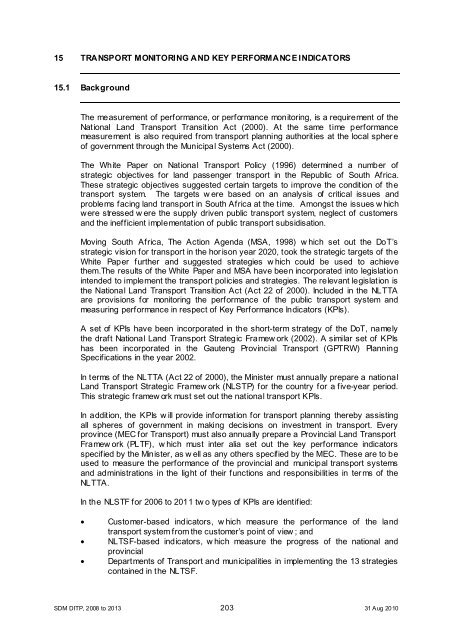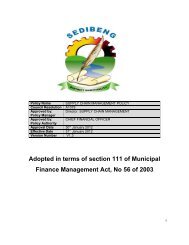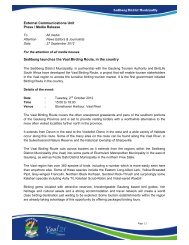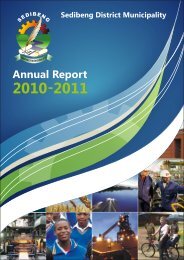Chapter 11 - Sedibeng District Municipality
Chapter 11 - Sedibeng District Municipality
Chapter 11 - Sedibeng District Municipality
Create successful ePaper yourself
Turn your PDF publications into a flip-book with our unique Google optimized e-Paper software.
15 TRANSPORT MONITORING AND KEY PERFORMANCE INDICATORS<br />
15.1 Background<br />
The measurement of performance, or performance monitoring, is a requirement of the<br />
National Land Transport Transition Act (2000). At the same time performance<br />
measurement is also required from transport planning authorities at the local sphere<br />
of government through the Municipal Systems Act (2000).<br />
The White Paper on National Transport Policy (1996) determined a number of<br />
strategic objectives for land passenger transport in the Republic of South Africa.<br />
These strategic objectives suggested certain targets to improve the condition of the<br />
transport system. The targets w ere based on an analysis of critical issues and<br />
problems facing land transport in South Africa at the time. Amongst the issues w hich<br />
were stressed w ere the supply driven public transport system, neglect of customers<br />
and the inefficient implementation of public transport subsidisation.<br />
Moving South Africa, The Action Agenda (MSA, 1998) w hich set out the DoT’s<br />
strategic vision for transport in the horison year 2020, took the strategic targets of the<br />
White Paper further and suggested strategies w hich could be used to achieve<br />
them.The results of the White Paper and MSA have been incorporated into legislation<br />
intended to implement the transport policies and strategies. The relevant legislation is<br />
the National Land Transport Transition Act (Act 22 of 2000). Included in the NLTTA<br />
are provisions for monitoring the performance of the public transport system and<br />
measuring performance in respect of Key Performance Indicators (KPIs).<br />
A set of KPIs have been incorporated in the short-term strategy of the DoT, namely<br />
the draft National Land Transport Strategic Framew ork (2002). A similar set of KPIs<br />
has been incorporated in the Gauteng Provincial Transport (GPTRW) Planning<br />
Specifications in the year 2002.<br />
In terms of the NLTTA (Act 22 of 2000), the Minister must annually prepare a national<br />
Land Transport Strategic Framew ork (NLSTP) for the country for a five-year period.<br />
This strategic framew ork must set out the national transport KPIs.<br />
In addition, the KPIs w ill provide information for transport planning thereby assisting<br />
all spheres of government in making decisions on investment in transport. Every<br />
province (MEC for Transport) must also annually prepare a Provincial Land Transport<br />
Framew ork (PLTF), w hich must inter alia set out the key performance indicators<br />
specified by the Minister, as w ell as any others specified by the MEC. These are to be<br />
used to measure the performance of the provincial and municipal transport systems<br />
and administrations in the light of their functions and responsibilities in terms of the<br />
NLTTA.<br />
In the NLSTF for 2006 to 20<strong>11</strong> tw o types of KPIs are identified:<br />
• Customer-based indicators, w hich measure the performance of the land<br />
transport system from the customer’s point of view ; and<br />
• NLTSF-based indicators, w hich measure the progress of the national and<br />
provincial<br />
• Departments of Transport and municipalities in implementing the 13 strategies<br />
contained in the NLTSF.<br />
SDM DITP, 2008 to 2013 203 31 Aug 2010
















